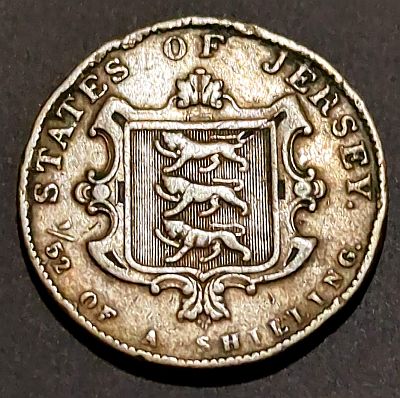An interesting fractional coin
Reverse

Which coin has the smallest value inscribed on it? Most currencies these days are decimal, with the smallest denomination coin equalling 1 / 100th of the main currency unit. One cent, for instance, or a penny. But generally they will say “1 cent” or “One Penny”. This coin, from Jersey, has “1/52 of a Shilling” written on it, below the shield of arms of the States of Jersey. Let’s start by looking at Jersey.
Jersey
Jersey is the largest of the “Channel Islands” – the islands in the English Channel between England and France. It is 14.5km (9 miles) wide and 8 kilometers (5 miles) long, sitting just 22km (14 miles) off the coast of France and 137 km (85 miles) south of the coast of England. It is a British Crown Dependency. That is, a possession of the British crown, but broadly self-administering.
Inhabited for a quarter of a million years, Jersey only became an island some 8,000 years ago. In 933, Jersey became part of the Duchy of Normandy. The island switched between British and French control several times over the next few centuries, but mostly remained an English possession. The French ruled Jersey for seven years during the War of the Roses 1461-1468. The French invaded again in 1781, capturing the capital, St Hellier, but being defeated by the British army. In WWII, the Channel islands were the only part of Britain to be occupied by German forces. The five year occupation coming to an end on 9th May 1945.
Jersey, Guernsey and the Isle of Man are part of the British Isles. England, Scotland and Wales make up Great Britain, while the United Kingdom includes Great Britain and Northern Ireland. Jersey is a British Crown Dependency.
Currency
Until 1834, Jersey used French Livre coins. These were exchangeable at 26 Livres to the British pound.
When France moved to the Franc in 1795, the supply of coins in Jersey dwindled. In September 1834, it was decreed that English money would be the sole legal tender in Jersey.
With 20 shillings to the pound and 20 sous to the livre, one shilling was worth 26 sous. Thus the Jersey penny or pièce de deux sous became 1/13th of a shilling, the Jersey half penny or sou 1/26th of a shilling, and the farthing or pièce de deux liards 1/52nd of a shilling. The first coins were struck in 1841 at the Royal Mint.
Confusion around the values – 13 pence to the shilling in Jersey compared to 12 pence to the shilling in the rest of the UK, eventually led to new coins of 1/48, 1/24 and 1/12th shilling in 1876.
Obverse

The obverse of the coin has the young bust of Victoria, similar to the Canadian 5 cents covered previously. The legend is slightly longer, reading “VICTORIA D: G: BRITANNIAR: REGINA F: D:” or “Victoria by the Grace of God Queen of the Britons Defender of the Faith”. This coin was engraved by William Wyon, father of Leonard Charles Lyon who engraved the Canadian piece.
As the smallest denomination issued in the first series of coins, this 1/52 of a Shilling coin is also a “KM1” coin. Similar to my 1931 Vatican City 5 Centesimi, this is the first coin listed for Jersey by Krause in the Standard Catalog of World Coins.

Here is the larger 1/13 of a Shilling coin from the same series.
Is this the smallest denomination displayed on a coin? What is the smallest or most unusual denomination you’ve seen? Share in the comments below!


Leave a Reply